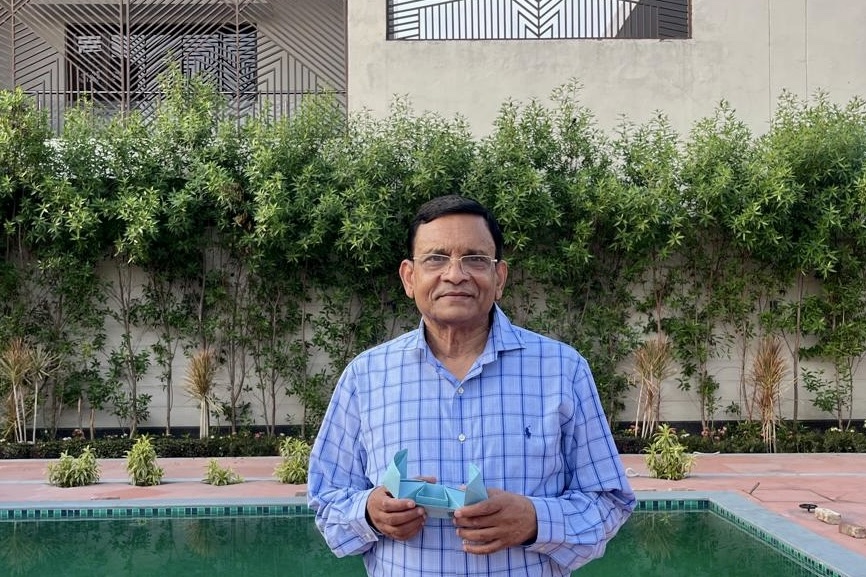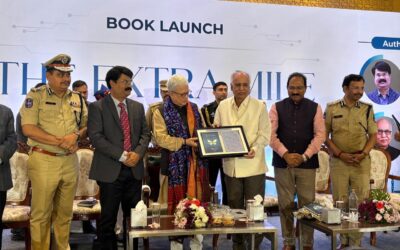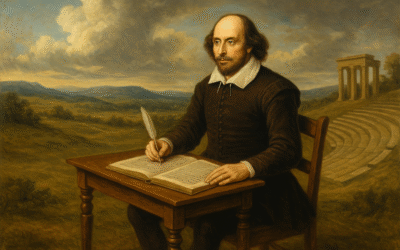Origami and the Science of Protein Folding

I have been blessed with the friendship of Manher Sameer. We met at GB Pant University in 1974, where I was pursuing my graduation in Mechanical Engineering, and where Sameer joined the Mechanical Engineering program after completing his graduation in Sciences from the adjacent College of Basic Sciences and Humanities. So technically, he was a year junior to me, but senior to me in all other respects – intelligence, skills and, above all, compassion.
I stayed back to teach after my graduation and completed my master’s in the process. Meanwhile, Sameer set up an ice factory in Moradabad as part of his family business and later established his enterprise in corrugated boards, an innovation at the time. Together, we named the new company ‘Paperphants’. It flourished and expanded over time. After I moved to Hyderabad in 1982, we became engrossed in our respective careers and families and lost in our busy schedules.
Sameer is gifted with excellent body-mind coordination, which usually manifests in sports. He is ambidextrous, playing with his left hand and writing with his right hand. He played cricket, badminton and table tennis at the University level. I loved watching him play table tennis – the way he would produce topspin, making the ball drop near the opposite side of the net and spin back, leaving his opponent no chance of reaching it. But more than that, I was intrigued by his skill in Origami.
Origami, derived from the Japanese words ‘oru’ (to fold) and ‘kami’ (paper), has evolved over centuries into both a hobby and an intricate art form. While traditional origami focuses on creating animals, flowers and geometric patterns, modern origami incorporates mathematical principles and engineering designs, pushing its boundaries beyond mere aesthetics.
Origami relies on a series of folds and unfolds, governed by simple rules that shape the paper into complex three-dimensional structures. The key lies in the crease patterns – mathematical blueprints that guide the transformation of a flat, usually square sheet of paper into an elegant figure. There is never a cut made and regardless of the complex shape you create, the paper can always be unfolded back to its original form. These folds require precision and adherence to geometric principles, often utilising angles, symmetry and proportion and demanding a very high degree of patience. There was nothing in the origami book that Sameer could not make.
In 2008, I met Dr. Arshad Quadri, MD, an Indian-origin cardiothoracic surgeon working in West Hartford, Connecticut, in the United States. He was married to the sister of my friend, radiologist Dr. Naiyer Imam, and they hosted me at their homes for a few days. I cherished this wonderful time with truly good people. Dr. Quadri took us to his lab and demonstrated his trials of folding a heart valve from bovine tissue using the origami technique.
The issue in paediatric cardiac care is that the valve needs to change as the child grows, which inspired him to come up with a prosthetic that could grow with the child. His origami-inspired heart valve prosthetic, made from live tissue, would address these challenges by expanding from paediatric to adult sizes while maintaining structural integrity and function. I had goosebumps seeing his work. I invited him to India for a collaboration, but he was already so deeply immersed in the US system that it was too late to turn back. The valve was never made.
Then, when my friend, Dr Girish Sahni (1956 – 2024), hosted me at his laboratory, the Institute of Microbial Technology (IMTECH) in Chandigarh, we stood in front of a giant haemoglobin mural at the G.N. Ramachandran Protein Centre. Trying his best to explain medical science to an engineer, Dr Sahni told me that all proteins are like long ribbons, and how they fold gives rise to different molecules. He also described the remarkable work of physicist Dr Ramachandran (1922 – 2001), who paved the way for the field of structural biology with his discovery of the dynamics of protein folding.
Correctly folded proteins perform a myriad of functions, such as catalysing enzymatic reactions, enabling cell signalling and providing structural support. For example, the precise folding of haemoglobin allows it to transport oxygen throughout the body, while the structure of collagen provides strength and elasticity to tissues. Misfolding can lead to various diseases, making protein folding one of the most critical processes in life sciences. Dr. Sahni praised G.N. Ramchandran’s work, stating that had he lived in the West, he would have been awarded a Nobel prize.
Origami and protein folding, though seemingly unrelated, share profound commonalities in their reliance on structure, precision and transformative processes. Origami, the ancient Japanese art of paper folding, embodies beauty through meticulous craftsmanship. In contrast, protein folding, a critical aspect of molecular biology, governs the functionality of life itself through the precise arrangement of amino acids.
Origami has transcended its artistic roots and found applications in science, technology and medicine. Engineers use origami-inspired designs to develop compact and deployable structures such as solar panels for spacecraft. In medicine, researchers have drawn inspiration from origami to create stents and other medical devices that can unfold in the body to minimise surgical invasiveness.
Computational models inspired by origami are helping scientists predict protein folding pathways. These tools use algorithms to simulate the folding process, enhancing our ability to design drugs and understand diseases. Origami-based designs are being integrated into nanotechnology and synthetic biology. Scientists are exploring ways to fold DNA and proteins into programmable structures, paving the way for breakthroughs in drug delivery, tissue engineering and the development of molecular machines.
Sameer, Dr Quadri, Dr Sahni… an engineer, a cardiac surgeon, a biologist… in hindsight, these people look like co-passengers in the journey of my life. Each participated in expanding my consciousness. Transcending mere acquaintance and delving into the realm of shared experiences, mutual respect, and emotional connection gives life its true meaning. A frog in the well may be a cruel metaphor, but if one has no friends beyond their family members and colleagues, they have not lived any better.
As life unfolds, revealing its complexities and joys, the definition of a friend evolves, shaped by both the richness of human interaction and the trials that test the strength of such bonds. A friend is not merely someone with whom we share time or interests; they are a mirror reflecting our aspirations, a confidant in our vulnerabilities and often a beacon guiding us through the labyrinth of existence.
Friendship is a living, breathing entity – one that adapts, evolves and grows as life unfolds. It is defined not by grand gestures but by the quiet moments of understanding, the shared experiences and the steadfast presence of someone who truly cares. As we journey through life, we come to realise that friends are the architects of our joy, companions in our sorrow and co-authors of our most cherished memories.
A friend, ultimately, reflects love–not platonic but functional, not transactional but unconditional; not fleeting but enduring. Thank you, Sameer, for being there for me and ensuring that I did not falter in my formative steps and wither away without blossoming. It was during my university days that I underwent a transformation, which allowed me to develop an open-minded attitude and a creative zeal. The wings I flew with to reach Dr Kalam were grown there – no wonder he could fold my career like a beautiful origami or a wholesome protein.
MORE FROM THE BLOG
The Lost Wisdom of Our Kitchens
There is a peculiar magic in the things we eat—an intimacy so daily, so habitual, that it becomes almost invisible. Food enters our bodies the way air enters our lungs: without ceremony, without question. We assume its shapes, its colours, its textures, as though they...
The Extra Mile
Shakespeare once reminded us that life is but a stage; listen closely, and beneath those familiar words, you can hear the soft hum of entrances and exits. Each of us arrives in medias res, as the Latins say—dropped into the middle of a vast, unfolding drama whose...
The Theatre Within
I have been fascinated by Shakespeare, as most of those fancy English phrases and words that enchanted me were created by this one man who lived in England during 1564–1616. I was always intrigued by how one individual could produce such a great body of work that...




What a deeply moving tribute to friendship, science, and the quiet magic of shared journeys. The way you connect origami, protein folding, and human bonds is nothing short of poetic. It’s not just Sameer ji’s brilliance that shines through…it’s your ability to recognize and reflect it with such grace. Thank you for always sharing your heart through your words.
Origami serves as a versatile and valuable educational tool that enhances various skills in students, including spatial reasoning, critical thinking, fine motor control, problem-solving, and creativity. It is particularly beneficial in subjects like mathematics and science, offering a hands-on approach to understanding abstract concepts like geometry and fractions.
Sir, Without knowing it is Origami, we used to make paper boats by folding paper. Some children can even make a ball. It is very common to create larger structures by making multiple folded sheets and wet-folding by using water to create rounded shapes.
Origami principles are utilised in designing shock absorbers, lightweight foldable helmets, and even in the development of robots capable of performing intricate tasks like retinal microsurgery. Great blog Sir!
Dear Sir, very informative blog. The benefits of origami-based solutions are many. Origami structures can be compactly stored and easily deployed when needed. Designs can be scaled from the micro to the meter level, expanding the range of potential applications. Some origami structures can fold or unfold autonomously in response to stimuli, reducing the need for external actuators. Designs can dynamically change their shape to adapt to different situations. Geometrical properties can be adjusted to tailor the material’s behaviour for specific tasks. Origami patterns can greatly simplify fabrication processes, reducing costs and assembly time. Thank you.
It is a fantastic story about how Origami, the ancient art of paper folding, has found diverse and impactful applications in modern science and technology, influencing fields from medicine and engineering to aerospace and robotics. The principles of folding allow for the creation of complex, deployable, and compact structures from flat sheets, leading to innovations in various sectors. May I add that NASA employs origami-inspired designs for deployable structures like the “starshade” prototype, which aims to block starlight for better exoplanet observation. Foldable materials inspired by origami can also be used for spacecraft components. Great to see Sameer Tauji’s picture.
A brilliant take on Origami, the art of paper folding, with protein folding. Both involve sequential folding steps to create complex structures from a simpler starting point. Just as a single sheet of paper can be folded into diverse origami models, a single protein chain can fold into various 3D structures. This analogy can inspire computational models for predicting protein folding pathways and understanding how misfolded proteins can lead to diseases—my salute and deep respect to you and your great friends. I come from Uttarakhand, and your mention of GB Pant University fills my heart with a sense of happiness and pride.
Thank you, Arun Tiwari Sir.
The interplay of friendship, art, and science is beautifully woven together, with Manhar Sameer serving as the central thread binding the narrative. The concepts of origami and protein unfolding are explained with remarkable clarity and simplicity, making science accessible and deeply engaging.
Allow me to digress a bit. It is only fitting to pause and acknowledge the quiet brilliance of Sameer Saheb (as his juniors and admirers fondly addressed him). He was renowned on the sports field for his unassuming yet formidable prowess as an all-rounder. Stories abound of his effortless adaptability—whether wielding the bat, delivering a deceptive off-spin, or marshalling his teammates with a calm authority that inspired confidence even in the tensest moments. His ability to read the game, anticipate its twists, and turn apparent disadvantages into opportunities marked him as a true student—and master—of sport. Those who watched him play team sports often remarked on his instinctive understanding, his commitment to the collective good over individual accolades, and the quiet pride he took in the successes of others. He was all grace and art in individual sports, too and excelled in Table Tennis and Badminton…which took most of his sporting time and left little time for practising cricket. And yet…
One inspiring memory
During the winter of 1975–76, the Pantnagar University cricket team travelled to Delhi to compete in the inter-university tournament. As a newcomer to the squad, I was assigned the role of 12th man, which meant I did not play but instead sat on the sidelines, positioned next to the players from Allahabad University—our opponents for the match. At the time, I was disappointed, believing myself to be more skilled than many of my teammates. However, this vantage point allowed me to observe the game closely and gain valuable insight. Our team struggled against the formidable pace bowling attack of Allahabad University, led by HN Dara, and we were dismissed for a paltry score in double digits.
In response, our fielding and our pace bowlers were most unimpressive, and Allahabad’s win by 10 wickets seemed probable. After a couple of overs, Manhar Sameer took up the bowling from the university end, and the tables soon turned. The settled openers, the 1st down and 2nd down, were tamed by the vast and sudden side movement of the off-spin. I still remember the dismissal of their top order … their star batsman leaving the ball that was lobbed on the edge of the pitch, and as he was posing for a copybook, well left moved sharply and dislodged the bails from the middle and off stump. The Allahabad camp went to a dead silence… Their coach and batsmen went into a huddle as to how to play Sameer Saheb. Yes, we lost, but thanks to Sameer Saheb, the team could leave the ground with their heads high.
On Sameer Saheb’s sportsman spirit.
I also recall his sportsman spirit in a cut-throat match at Pantnagar Central Cricket Ground. It was a junior vs senior match and contested in the fiercest spirits, danger players were strategically marked…pliable umpires were instructed to oust the key opponents. The pace bowlers were easy to play for me, and Sameer Saheb was brought early for my dismissal. I had also strategised only to play his straight balls with bat and pad or let go of the rest. As I padded a sharp off-spinner of Sameer Saheb, all nine fielders appealed in the loudest of their voices for my dismissal, except, of course, Sameer Saheb and Pradeep Awasthi Sir, the wicket keeper and their captain. The planted umpire was quick to raise his finger… As I hesitantly moved towards the pavilion, I was brought back by Awasthi Sir…with Sameer Saheb’s proactive consent.
I’d like to ask Sunil Kaul Saheb, another accomplished all-rounder and a prolific writer (I recommend that all my Pant Nagar friends read his books as well), to recall the incident and provide further comment.
Excellence begets excellence. I often wondered if Arun Tiwari Sir’s remarkable growth as an innovator and writer was, in part, nurtured by his friendship with Sameer Saheb during his formative years. I have now got my answer from Tiwari Sir.
As a curious reader and lifelong learner, I wish to learn more about the other two—Dr. Arshad Quadri and Dr. Girish Sahni—whose contributions, I hope, will be explored further by Tiwari Sir in his future writings.
Professor Sahab, you started with your friend and took us to Dr.Ramachandran, Origami, protein folding and finally to friendship.
Arun Ji, thank you for clarifying and reinforcing concepts on friendship as a living, breathing entity. Friends as companions in sorrow and architects in joy. Great.
Dear Sir, Greetings! Thank you for sharing such a deeply reflective and beautifully interwoven narrative. Through your journey with Sameer ji, Dr. Quadri, and Dr. Sahni, you’ve illuminated the quiet yet profound impact of friendships and intellectual kinship. The parallels drawn between origami and protein folding are not only scientifically insightful but also metaphorically powerful, reminding us that precision, structure, and evolution define not only matter but also relationships and life itself.
Your words are a tribute to the silent architects of our growth—friends who shape us without fanfare, much like the unseen folds in origami that give shape to a masterpiece. It’s incredibly inspiring to witness how your formative experiences nurtured the vision that eventually soared alongside Dr. Kalam. Thank you for turning memories into meaning and for showing us the elegance in life’s intricate folds. Warm regards.
From Paperphants to proteins—what an incredible journey! This post is not only a tribute to a friend but also a masterclass in how curiosity and connection create meaning across disciplines. I’m deeply moved.
Respected Arun Tiwari Sir, Your blog has superbly illustrated a connection between Origami and the correct way of protein molecular folding. Mr. Sameer, Dr. Quadri, and Dr. Sahni have been great stalwarts in engineering, cardiac surgery, and biology. Thank you for highlighting the origins of Origami and its applications in various fields, including medicine and aircraft design.
I’m looking forward to reading more blogs like this in the future.
Der Prof
What a beautiful tale of friendship and the meaning of life! Thank you for sharing this.
Arunji, a deeply moving tribute that beautifully connects friendship, science, and art. The journey from campus memories to cutting-edge innovation through origami and protein folding is both inspiring and humbling. Thank you for sharing such profound insights and stories!